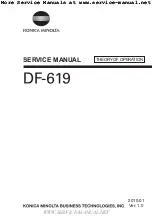
HARRIS
220 Series
Gas Distribution Equipment
Installation and Operation Manual
Switchover System
THIS BOOKLET CONTAINS PROPRIETARY INFORMATION FROM THE HARRIS PRODUCTS GROUP. IT IS PROVIDED TO THE PURCHASER SOLELY FOR USE IN CONJUNCTION WITH AUTOMATIC
SWITCHOVER MANIFOLDS MODEL 220 SERIES.
Important
Installation and operation of compressed gas equipment should only be performed by experienced operators and installers who know the general principles and safety precautions to be
observed in handling compressed gases. If you are not certain you fully understand the safety precautions for handling compressed gases, please contact The Harris Products Group,
or, your local gas supplier.
Do not permit untrained persons to install, operate or maintain this equipment. Do not attempt to install or operate this equipment until you have read and fully understand these
instructions. If you do not fully understand these instructions, contact The Harris Products Group.
Extra copies of this instruction manual are available from The Harris Products Group upon request.
1. General Safety Precautions
Protect yourself and others. Read and understand the following instructions before attempting to use this equipment. Failure to understand and follow these instructions can result
in serious personal injury and/or damage to the equipment. Because of the many potential hazards associated with compressed gases, read the Material Safety Data Sheet for each
gas you will be using.
1. Know and understand the physical and chemical properties of the gas being used.
2. Observe general precautions for the use of gases.
3. Observe safety precautions for the gas being used.
4. Do not use this equipment with gases that are not compatible with the materials of construction. The use of gases not compatible with the materials of construction may cause
damage to the equipment or injury to personnel.
5. If flammable gases are used with this equipment do not locate it near open flames or any other source of ignition.
6. If toxic or flammable gases are used with this equipment, emergency equipment applicable to the gases in use should be available in close proximity.
7. Many gases can cause asphyxiation by displacing oxygen in the atmosphere. Make certain the area where these manifolds are operated is well ventilated.
8. Do not release asphyxiant, toxic or flammable gases in the vicinity of personnel. Use this equipment only in well ventilated areas. Vent gases to the outside atmosphere and in an
area away from personnel. Be sure that venting and disposal methods are in accordance with Federal, State, Provincial and local requirements. Locate and construct vent lines to
prevent condensation or gas accumulation. Be sure the vent outlet cannot be obstructed by rain, snow, ice, insects, birds, etc. Do not inter-connect vent lines; if more than one vent
is needed, use separate lines.
9. Relief devices should be installed and properly vented in all gas handling systems to protect against equipment failure and over-pressurization.
10. Never connect this equipment to a supply source having a pressure greater than the maximum rated pressure. Refer to the Product Specifications for maximum inlet pressures.
11. Never permit oil, grease or other combustible materials to come in contact with cylinders, manifolds, and connections. Oil and grease may react and ignite when in contact with
some gases – particularly oxygen and nitrous oxide.
12. Cylinder, header, and master valves should always be opened very s-l-o-w-l-y. Heat of recompression may ignite combustible materials.
13. Flexible hoses should never be kinked, twisted or bent into a radius smaller than 3 inches. Mistreatment may cause the flexible hoses to burst.
14. Do not apply heat. Some materials may react and ignite while in contact with some gases – particularly oxygen and nitrous oxide.
15. Cylinders should always be secured with racks, chains, or straps. Unrestrained cylinders may fall over and damage or break off the cylinder valve which may propel the cylinder
with great force.
16. Welding should not be performed near nitrous oxide piping. Excessive heat may cause the gas to dissociate, creating an explosive force.
17. Do not use leak test solution that contains ammonia. Solutions containing ammonia may cause brass tubing to crack.
220 SERIES
SWITCHOVER MANIFOLD
220 SERIES
SWITCHOVER MANIFOLD
220 SERIES
SWITCHOVER MANIFOLD
10
12
13
8
6
4
2
50
-30
0
100
150
200
-1
0
LEFT BANK
EMPTY
NORMAL
EMPTY
NORMAL
RIGHT BANK


































